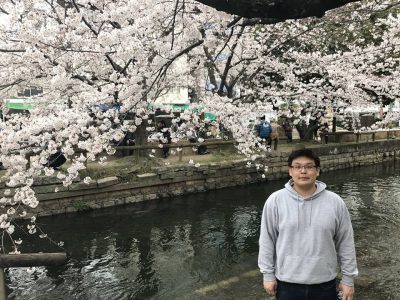Historians Abroad: Hands-on History in Japan
In this post, undergraduate student Ken Yoshida tells us what it’s like to be the first Carleton student to study at Okayama University in Japan and what it’s like to study history in Japan.

When student Ken Yoshida arrived at Okayama, Japan this past April, he was just in time to see the cherry blossoms and just in time to start the new school year. Cherry blossoms, after all, signal a new start.
Ken is the first Carleton student to study at Okayama University, a national university which has been designated as a “Top Global University” by the Japanese government. It is Japan’s second largest university and its patterns and rhythms offer a marked change to studying in Ottawa.
First, there’s the different academic calendar. Okayama University operates on a “Quarter System” with eight weeks per quarter, and four quarters in one academic year. Courses either last only one quarter or span over two quarters, but not for the whole academic year. The daily rhythm of classes is different as well. The university chimes its bells at official breaks, and to mark the beginning and end of each class.
Ken’s class time is divided between Japanese language classes and a number of academic courses that have been created purposely for exchange students or for Japanese students who want to study in English.
For Ken, studying at Okayama has allowed him to participate in a ground-breaking course in East Asian urban history and to conduct field work in historic Kobe, Japan. As a student in Dr. Yunlian Chen’s “Urban History of the East Asian Region,” he is studying how both architecture and history can help explain the urban development of the region. The course includes obligatory field trips (referred to as “field work”). Rather than write lengthy research papers or exams, students are assessed on their participation in these outings.
His urban history class explored the port and foreign concession areas of Kobe. The class was able to view up close the architectural styles from the late Tokugawa and early Meiji eras and to explore the physical landscapes that emerged from these pivotal moments in Japanese history. All the while, students were quizzed about the buildings and their evolving purposes. “We were able to see these historic buildings in person and to learn and discuss their significance,” he notes. It’s as though you could reach out and touch history.
Since all exchange students at Okayama University are required to enroll in a mandatory research course and to pursue a research project related to a Japanese topic, Ken took inspiration from his Carleton coursework. In the History department’s second-year required course, the Historians’ Craft, “I learned that picture postcards, photographs or any visual material can be used as primary sources for historical research. I decided to research Japanese postcards and woodblock prints from the Meiji era.” The project is in its early stages and will provide a focus for his work during the winter.
When asked about what advice he would offer to students considering studying abroad as part of their undergraduate History degree, Ken is unequivocal: “Just do it.” “No matter how much you Google about the country, the city, and the university, it is nothing like experiencing the location yourself,” he notes. Despite facing the cultural, linguistic and other challenges that come with studying abroad, the experience and knowledge he has already acquired from his stay in Japan have been more than worth it. And he’s only just at the midpoint of his stay.